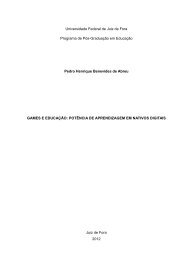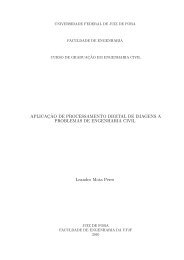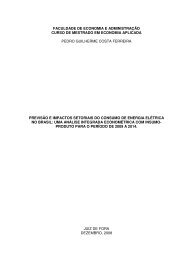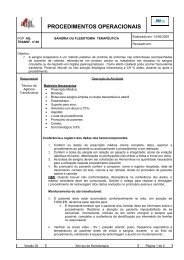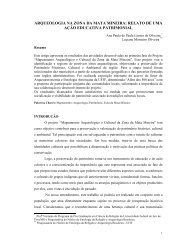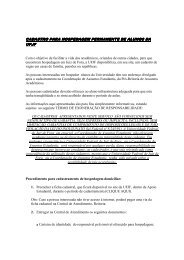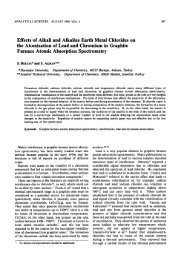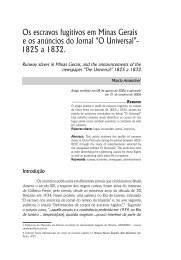Volume 6 | Número 2 Julho - Dezembro de 2012 - Universidade ...
Volume 6 | Número 2 Julho - Dezembro de 2012 - Universidade ...
Volume 6 | Número 2 Julho - Dezembro de 2012 - Universidade ...
You also want an ePaper? Increase the reach of your titles
YUMPU automatically turns print PDFs into web optimized ePapers that Google loves.
Psicologia em Pesquisa | UFJF | 6(02) | 139-150 | <strong>Julho</strong>-<strong>Dezembro</strong> <strong>de</strong> <strong>2012</strong><br />
Kessels, R. P., van Zandvoort, M. J., Postma, A.,<br />
Kappelle, L. J., & <strong>de</strong> Haan, E. H. (2000). The Corsi<br />
Block-Tapping Task: standardization and normative<br />
data. Applied Neuropsychology, 7(4), 252-258.<br />
Kopera-Frye K., Dehaene S., & Streissguth A. P.<br />
(1996). Impairments of number processing induced<br />
by prenatal alcohol exposure. Neuropsychologia,<br />
34(12), 1187-1196.<br />
Lan<strong>de</strong>rl, K., Bevan, A., & Butterworth, B. (2004).<br />
Developmental dyscalculia and basic numerical<br />
capacities: A study of 8-9-yearold stu<strong>de</strong>nts.<br />
Cognition, 93(2), 99-125.<br />
Lan<strong>de</strong>rl, K., Fussenegger, V., Moll, K., &<br />
Willburger, E. (2009). Dyslexia and dyscalculia:<br />
two learning disor<strong>de</strong>rs with different cognitive<br />
profiles. Journal of Experimental Child Psychology,<br />
103(3), 309-324.<br />
Lan<strong>de</strong>rl, K., & Moll, K. (2010). Comorbidity<br />
of learning disor<strong>de</strong>rs: prevalence and familial<br />
transmission. The Journal of Child Psychology and<br />
Psychiatry, and Allied Disciplines, 51(3), 287-294.<br />
LeFevre, J. A., Fast, L., Skwarchuk, S. L., Smith-<br />
Chant, B. L., Bisanz, J., Kamawar, D., & Penner-<br />
Wilger, M. (2010). Pathways to mathematics:<br />
longitudinal predictors of performance. Child<br />
Development, 81(6), 1753-1767.<br />
Lezak, M. D., Howieson, D. B., Bigler, D. B., &<br />
Tranel, D. (<strong>2012</strong>). Neuropsychological Assessment<br />
(5th ed., pp. 666-711).<br />
Mazzocco, M. M. M., & Myers, G. F. (2003).<br />
Complexities in i<strong>de</strong>ntifying and <strong>de</strong>fining<br />
mathematics learning disability in the primary<br />
school-age years. Annals of Dyslexia, 53(1), 218-253.<br />
Mazzocco, M. M. M., & Thompson, R. E. (2005).<br />
Kin<strong>de</strong>rgarten predictors of math learning disability.<br />
Learning Disabilities Research & Practice: a<br />
publication of the Division for Learning Disabilities,<br />
Council for Exceptional Children, 20(3), 142-155.<br />
Mazzocco, M. M. M. (2007). Defining and<br />
differentiating mathematical learning disabilities<br />
and difficulties. In D. B. Berch & M. M. M.<br />
Mazzocco (Eds.), Why is math so hard for some<br />
children? The nature and origins of mathematical<br />
learning difficulties and disabilities, (pp. 29-47),<br />
Baltimore: Brookes.<br />
Mazzocco, M. M., Feigenson, L., & Halberda,<br />
J. (2011). Impaired acuity of the approximate<br />
number system un<strong>de</strong>rlies mathematical learning<br />
disability (dyscalculia). Child Development, 82(4),<br />
1224-1237.<br />
McKenzie, B., Bull, R., & Gray, C. (2003). The effects<br />
of phonological and visual-spatial interference on<br />
children’s arithmetical performance. Educational<br />
and Child Psychology, 20(3), 93-108.<br />
Miyake, A., Friedman, N. P., Emerson, M. J., Witzki,<br />
A. H., Howerter, A., & Wager, T. D. (2000). The<br />
unity and diversity of executive functions and their<br />
contributions to complex “Frontal Lobe” tasks: a<br />
latent variable analysis. Cognitive Psychology, 41(1),<br />
49-100.<br />
Parsons, S., & Bynner, J. (1997). Numeracy and<br />
employment. Education + Training, 39(2), 43-51.<br />
Piazza, M., & Dehaene, S. (2004). From number<br />
neurons to mental arithmetic: the cognitive<br />
neuroscience of number sense. In M. Gazzaniga,<br />
(Ed.), The Cognitive Neurosciences, (pp. 865-875),<br />
Cambridge: MIT Press Book.<br />
Piazza, M., Facoetti, A., Trussardi, A. N., Berteletti,<br />
I., Conte, S., Lucangeli, D., Dehaene, S., & Zorzi,<br />
M. (2010). Developmental trajectory of number<br />
acuity reveals a severe impairment in <strong>de</strong>velopmental<br />
dyscalculia. Cognition, 116(1), 33-41.<br />
Raghubar, K. P., Barnes, M. A., & Hecht, S. A.<br />
(2010). Working memory and mathematics: A<br />
review of <strong>de</strong>velopmental, individual difference,<br />
and cognitive approaches. Learning and Individual<br />
Differences, 20(2), 110-122.<br />
Rourke, B. P. (1989). Nonverbal learning disability.<br />
The syndrome and the mo<strong>de</strong>l. New York: Guilford.<br />
Rousselle, L., & Noël, M. P. (2007). Basic numerical<br />
skills in children with mathematics learning<br />
disabilities: a comparison of symbolic vs. nonsymbolic<br />
number magnitu<strong>de</strong> processing.<br />
Cognition, 102(3), 361-395.<br />
Rubinsten, O., & Henik, A. (2005). Automatic<br />
activation of internal magnitu<strong>de</strong>s: a study of<br />
<strong>de</strong>velopmental dyscalculia. Neuropsychology, 19(5),<br />
641-648.<br />
Rubinstein, O., & Henik, A. (2009). Developmental<br />
dyscalculia: heterogeneity might not mean<br />
different mechanisms. Trends in Cognitive Sciences,<br />
13(2), 92-99.<br />
Shalev, R. S., Manor, O., & Gross-Tsur, V. (2005).<br />
Developmental dyscalculia: a prospective six-year<br />
follow-up. Developmental Medicine and Child<br />
Neurology, 47(2), 121-125.<br />
Simmons, F. R., & Singleton, C. (2007). Do weak<br />
phonological representations impact on arithmetic<br />
<strong>de</strong>velopment? A review of research into arithmetic<br />
and dyslexia. Dyslexia, 14(2), 77-94.<br />
Haase, V. G., Costa, A. J., Antunes, A. M. & Alves, I. S. 149



